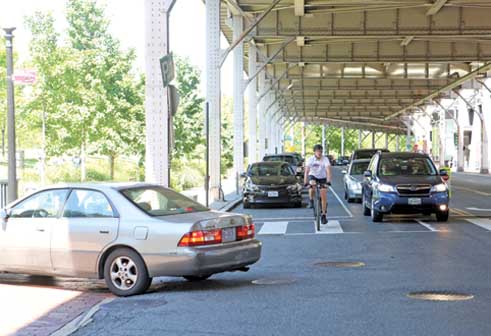Park Service Spells Out Ideas for Trail Network

By Mark LiebermanCurrent Staff Writer
A new National Park Service plan includes a host of recommended improvements to nearly 100 miles of paved trails within the D.C. area.
The 172-page document features more than 100 recommendations large and small. Some of the main recommendations affect areas in Northwest, among them improving visitor safety and reducing pedestrian and motorist conflicts at Lincoln Memorial Circle; conducting a feasibility study for a cycle track or trail along Military Road NW from Glover Road NW to 16th Street NW; and conducting a feasibility study for a trail facility along the Oregon Avenue NW corridor.
The document also has recommendations for improvements to the Capital Crescent Trail in Georgetown, including closing the gap from 30th to 31st streets NW through an analysis of the Water Street corridor and evaluating potential access improvements from the Capital Crescent Trail to the Key Bridge.
The overall goal of the study is to make the city’s network of trails more interconnected while simultaneously promoting natural and historic resources, according to the study document. The study came together through a review of the trail network’s “baseline conditions” and a daylong visioning exercise conducted by National Park Service staffers.
The Georgetown Business Improvement District has also been working to improve the trail network in its neighborhood, with a provision in its “Georgetown 2028” plan that calls for similar efforts to connect disparate pieces of the several trails that converge near Georgetown Waterfront Park. The business improvement district’s transportation director, Will Handsfield, told The Current that he’s particularly pleased to see the Park Service embracing the possibilities for trails as transportation options.
“It’s really important that the Park Service is, in writing and with the backing of a very thorough plan, stating the importance of what used to be just considered recreational resources,” Handsfield said.
Handsfield said he and his colleagues provided guidance to the National Park Service as it approached ideas for trail improvements. He advised the Park Service to pay special attention to the grade changes that make travel tricky in areas like the path from the Key Bridge to the C&O Canal towpath, which lies 85 feet above the Capital Crescent trail despite appearing closer than that.
The business group has already drafted plans for a cycle track on the south side of Water Street NW that will bridge the gap between the end of the Capital Crescent Trail and the start of the Rock Creek Trail a few blocks away. If a planned streetcar line arrives in Georgetown in the next few years, that cycle track would be shifted into the waterfront park itself.
Handsfield hopes that the end result will be a trail system able to manage a large number of people in a very small space.
“The feeling of it will be a really positive experience to be in there and using the system,” Handsfield said. “It’ll feel like it was designed for you.”
In addition to the location-specific recommendations, the study also offers eight programmatic recommendations, including to develop a National Park Service regional trails coordinator; a comprehensive manual of trail standards; protocols for incident reporting and data collection; and a National Capital Trail marketing and promotion program.
Katie Harris from the Washington Area Bicyclist Association told The Current that she’s excited that trails will be held to the same uniform standards as roads.
“We want to commend them on a job well done, but also acknowledging that there’s a lot of work ahead to turn this plan into an on-the-ground network,” Harris said.
Handsfield thinks D.C.’s trail system has a “competitive advantage” over other urban centers, and he hopes the outcomes of this study increase that advantage.
“It’s a really great trail network that you can ride around as your primary or secondary mode of transportation,” Handsfield said. “Very few places in America are like that.”
This article appears in the Sept. 7 issue of The Georgetown Current newspaper.




